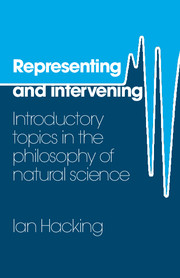Book contents
- Frontmatter
- Acknowledgements
- Contents
- Analytical table of contents
- Preface
- Introduction: Rationality
- Part A Representing
- Part B Intervening
- 9 Experiment
- 10 Observation
- 11 Microscopes
- 12 Speculation, calculation, models, approximations
- 13 The creation of phenomena
- 14 Measurement
- 15 Baconian topics
- 16 Experimentation and scientific realism
- Further reading
- Index
16 - Experimentation and scientific realism
Published online by Cambridge University Press: 05 June 2012
- Frontmatter
- Acknowledgements
- Contents
- Analytical table of contents
- Preface
- Introduction: Rationality
- Part A Representing
- Part B Intervening
- 9 Experiment
- 10 Observation
- 11 Microscopes
- 12 Speculation, calculation, models, approximations
- 13 The creation of phenomena
- 14 Measurement
- 15 Baconian topics
- 16 Experimentation and scientific realism
- Further reading
- Index
Summary
Experimental work provides the strongest evidence for scientific realism. This is not because we test hypotheses about entities. It is because entities that in principle cannot be ‘observed’ are regularly manipulated to produce a new phenomena and to investigate other aspects of nature. They are tools, instruments not for thinking but for doing. The philosopher's favourite theoretical entity is the electron. I shall illustrate how electrons have become experimental entities, or experimenter's entities. In the early stages of our discovery of an entity, we may test the hypothesis that it exists. Even that is not routine. When J.J. Thomson realized in 1897 that what he called ‘corpuscles’ were boiling off hot cathodes, almost the first thing he did was to measure the mass of these negatively charged particles. He made a crude estimate of e, the charge, and measured e/m. He got m about right, too. Millikan followed up some ideas already under discussion at Thomson's Cavendish Laboratory, and by 1908 had determined the charge of the electron, that is, the probable minimum unit of electric charge. Hence from the very beginning people were less testing the existence of electrons than interacting with them. The more we come to understand some of the causal powers of electrons, the more we can build devices that achieve well-understood effects in other parts of nature. By the time that we can use the electron to manipulate other parts of nature in a systematic way, the electron has ceased to be something hypothetical, something inferred.
Information
- Type
- Chapter
- Information
- Representing and InterveningIntroductory Topics in the Philosophy of Natural Science, pp. 262 - 275Publisher: Cambridge University PressPrint publication year: 1983
Accessibility standard: Unknown
Why this information is here
This section outlines the accessibility features of this content - including support for screen readers, full keyboard navigation and high-contrast display options. This may not be relevant for you.Accessibility Information
- 2
- Cited by
